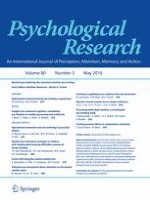04-02-2016 | Review
Insights into numerical cognition: considering eye-fixations in number processing and arithmetic
Gepubliceerd in: Psychological Research | Uitgave 3/2016
Log in om toegang te krijgenAbstract
Considering eye-fixation behavior is standard in reading research to investigate underlying cognitive processes. However, in numerical cognition research eye-tracking is used less often and less systematically. Nevertheless, we identified over 40 studies on this topic from the last 40 years with an increase of eye-tracking studies on numerical cognition during the last decade. Here, we review and discuss these empirical studies to evaluate the added value of eye-tracking for the investigation of number processing. Our literature review revealed that the way eye-fixation behavior is considered in numerical cognition research ranges from investigating basic perceptual aspects of processing non-symbolic and symbolic numbers, over assessing the common representational space of numbers and space, to evaluating the influence of characteristics of the base-10 place-value structure of Arabic numbers and executive control on number processing. Apart from basic results such as reading times of numbers increasing with their magnitude, studies revealed that number processing can influence domain-general processes such as attention shifting—but also the other way round. Domain-general processes such as cognitive control were found to affect number processing. In summary, eye-fixation behavior allows for new insights into both domain-specific and domain-general processes involved in number processing. Based thereon, a processing model of the temporal dynamics of numerical cognition is postulated, which distinguishes an early stage of stimulus-driven bottom-up processing from later more top-down controlled stages. Furthermore, perspectives for eye-tracking research in numerical cognition are discussed to emphasize the potential of this methodology for advancing our understanding of numerical cognition.
